The Suniva Trade Case, Finding (and Funding) the Good Guys
On April 17, 2017, Suniva – a maker of crystalline silicon photovoltaic (PV) solar cells and modules – filed for Chapter 11 bankruptcy status.
No one in the solar energy industry was very surprised. Two weeks earlier, Suniva had laid off 131 workers from its Norcross, Georgia headquarters and plant, and shuttered its Saginaw, Michigan facility.
In just a single month, hard-pressed Suniva - once the darling of both state and federal governments, which provided startup funds for the 2007 Georgia Tech enterprise – went from golden to grappling for a handhold.
As early as March, Suniva had been complaining of downward market pricing measures (read China solar cell and panel prices undercutting the U.S.). China, in its attempt to make everything America uses or needs, had hugely expanded solar panel production.
This was very good for American consumers, who saw solar panels on the roof as both the ultimate bit of kitsch (affordable to only about 10 percent of Americans, namely the millionaires), or a very valuable environmental platform that was worth going into debt for.
The problem was wider than China, however. It was, in fact, global overcapacity – on a scale with the global oil market – and the only way to reverse any glut is to cut back production. The Chinese did not get the memo. In 2015, solar panel manufacturer Shunfeng International Clean Energy bought a majority stake in Suniva that was intended to boost its sales and subvert the intent of tariffs levied in 2014 on overseas solar manufacturing. The EU had already imposed its provisional anti-dumping tariffs a year earlier.
First Solar, a solar panel manufacturer and installer based in Tempe, Ariz., reportedly lost $358 million in 2016 on rock-bottom solar prices and a reduction in utility-scale projects. From June 2016 to this year, First Solar’s share price had dropped more than 60 percent. Surprisingly, the solar firm came back in Q1 with a $491 million cash position, and guidance was upgraded.
Suniva on April 26 of this year filed a petition based on Sections 201 and 202 of the Trade Act of 1974. Section 201 states: “an article is being imported into the United States in such increased quantities as to be a substantial cause of serious injury, or threat thereof, to the domestic industry producing an article like or directly competitive with the imported article.”
Section 202 provides the terms for Presidential action after the investigation is complete and the commission determines that increased imports have been a “…substantial cause of serious injury or the threat thereof with respect to an industry”. The imports covered in this investigation include crystalline silicon, in addition to other photovoltaic materials.
On May 23, the International Trade Commission (ITC) officially accepted the petition. Suniva, not content to wait for a determination in a case the ITC has called “extraordinarily complicated” has instead request President Trump to impose a four-year moratorium on imported solar modules ($0.78 per watt), and cells ($0.40). At this level, module pricing would revert to 2012 levels, and the solar installation industry would be seriously hampered.
The move is not arbitrary. China produces most of the world’s solar cells and modules, but other nations in Southeast Asia also contribute, and the biggest of these are Taiwan, Vietnam, and Thailand. The biggest overseas solar manufacturers are Trina Solar, JA Solar, and Hanwha Cells.
The Solar Energy Industries Association, or SEIA, is opposed to any trade barriers and argues that the existing administration should be able to protect the 2,000 jobs in the nation’s crystalline silicon solar cell and panel installation industry without trade barriers.
SolarWorld, as the biggest crystalline-silicon manufacturer in the U.S., says that the Suniva request is just further proof that the U.S. solar manufacturing industry still suffers from unfair trade practices. Observers agree that the U.S. solar installation industry is off its stride, and has been since the middle of 2016. Most experts put the decline down to an incoming administration. If the tariff is enacted, planned utility-scale solar projects will be put back on the shelf, to gather dust, and a number of state markets will be beyond the purview of residential installers as well.
An injury hearing will take place at 9:30 a.m. on August 15 at the International Trade Commission headquarters in Washington, D.C. If the ITC determines harm, an additional hearing on remedy will take place at 9:30 a.m. on October 3. I guess we will have to wait and see who the good guy is.




